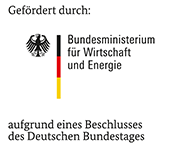263 ZN

| Period: | 01.11.2007 - 30.04.2010 |
|---|---|
| Partner: | Biofilmcenter University Duisburg-Essen |
| Funder: | AiF |
| Project Manager: | M.Sc. David Holuscha |
| Research Group: | Corrosion |
The use of microorganisms for corrosion protection seems still astonishing as one normally associates microorganisms with the opposite of corrosion protection. Indeed, microbial activity is reported to cause high amounts of costs due to plant failures including loss of production and expensive repairing. This type of corrosion is referred to as microbially influenced corrosion (MIC) where biofilms are of crucial importance. Of high importance for the adsorption of bacteria and the development of the biofilm are extracellular polymeric substances (EPS) which are excreted by the microorganisms.
However, the presence of some microorganisms can also cause a decrease of the corrosion rate of metals. Concerning the mechanisms of these 'protective biofilms' the formation of protective passivating layers or oxygen depletion beneath the biofilm are discussed. Still unclear remains the protective effect observed in the presence of intentionally killed cells. Also EPS are of high interest as some are found to inhibit the adsorption of microorganisms.
Protective biofilms are of special interest as they are promising candidates for the mandatory replacement of harmful methods of corrosion protection currently in use. These biofilms can be considered as cheap and renewable resources. Appropriate EPS could be applied in terms of a repellent for harmful microorganisms.
The aim of this project is therefore to study the applicability of biofilms or pure EPS in order to establish a new protection method for iron and steel surfaces against corrosion in aqueous media. Initial experiments have been performed dealing with sulphate-reducing bacteria (SRB) and isolated EPS. The corrosion behaviour of iron and steel substrates was evaluated by electrochemical and microscopic techniques, like AFM. Of special interest are the adsorption properties of biofilm or EPS that show protective properties. In order to perform long-term examinations a test circuit (miniplant technique) was established.
back

Das IGF-Vorhaben Nr. 263 ZN der Forschungsvereinigung DECHEMA e.V., Theodor-Heuss-Allee 25, 60486 Frankfurt am Main wurde über die AiF im Rahmen des Programms zur Förderung der industriellen Gemeinschaftsforschung (IGF) vom Bundesministerium für Wirtschaft und Energie aufgrund eines Beschlusses des Deutschen Bundestages gefördert.
Contact |
| Prof. Dr.-Ing. Wolfram Fürbeth |
| Telefon: +49 69 / 75 64-398 E-Mail: fuerbeth |
Publications |
| M. Grooters, K. Harneit, M. Wöllbrink, W. Sand, R. Stadler , W. Fürbeth Advanced Materials Research 20-21 (2007) 375-378 |
| R. Stadler, W. Fürbeth, K. Harneit, M. Grooters, M. Wöllbrink, W. Sand Electrochimica Acta 54 (2008) 91-99 |